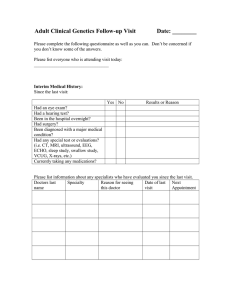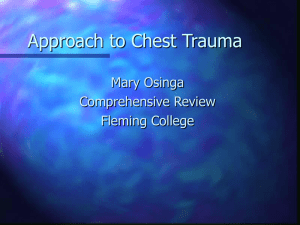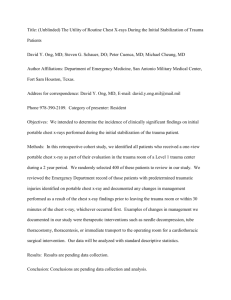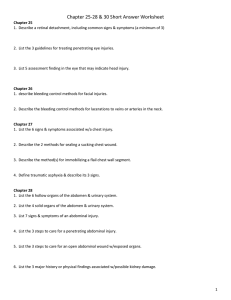Head, Spine, & Chest Injuries
advertisement
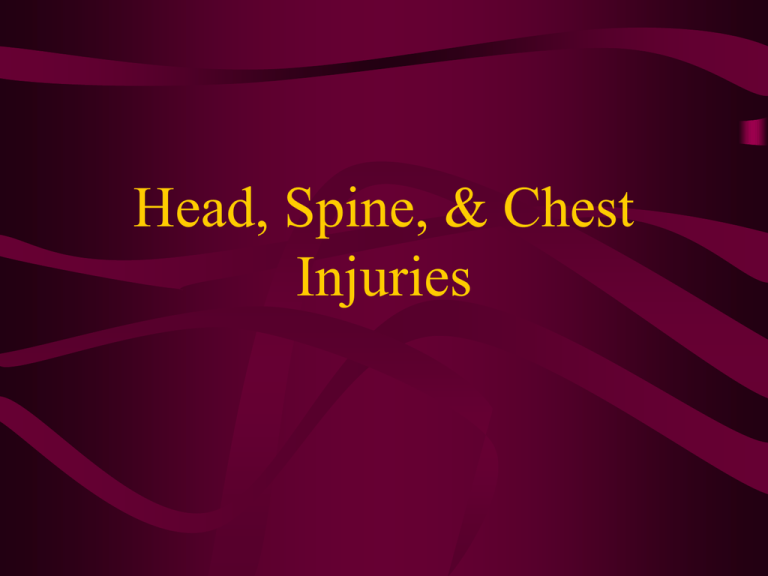
Head, Spine, & Chest Injuries Head Injuries • Leading cause of death due to trauma • Major causes: – Airway compromise – Brain stem laceration, c-spine lesion • Death within 1-3 hours: – Epidural hematoma – Subdural hematoma Significant Mechanisms of Injury • • • • • • • • Motor vehicle crashes Pedestrian-motor vehicle collisions Falls Blunt or penetrating trauma Motorcycle crashes Hangings Driving accidents Recreational accidents Head Injury Types • Scalp lacerations • Skull fractures (open or closed) • Brain injuries • Medical conditions • Complications of head injuries Scalp Lacerations • Scalp is extremely vascular (lots of blood.) • Remember that there may be more serious, deeper injuries. • Fold skin flaps back down onto scalp. • Control bleeding by direct pressure. Skull Fracture • Indicates significant force • Signs – Obvious deformity – Visible crack in the skull – Raccoon eyes – Battle’s sign Skull Fractures Concussion • Brain injury • Temporary loss or alteration in brain function • May result in unconsciousness, confusion, or amnesia (repetitive sayings) • Brain can bruise when skull is struck • Internal bleeding & swelling • Bleeding will increase pressure within the skull Coup/Contrecoup Injuries Intracranial Bleeding • Laceration or rupture of blood vessel in brain – Subdural – Intracerebral – Epidural Other Brain Injuries • Brain injuries are not always caused by trauma. • Medical conditions may cause spontaneous bleeding in the brain. • Signs and symptoms of nontraumatic injuries are the same as those of traumatic injuries…there is no mechanism of injury. Complications of Head Injury • • • • Cerebral edema Convulsions and seizures Vomiting (airway compromise) Leakage of cerebrospinal fluid Assessing Head Injuries • Common causes, think MOI: – Motor vehicle crashes – Direct blows – Falls from heights – Assault – Sports Injuries • Evaluate and monitor LOC Head Injury Signs and Symptoms • Lacerations, contusions, hematomas to scalp • Soft areas or depression upon palpation • Visible skull fractures or deformities • Ecchymosis around eyes and behind the ear (remember these are LATE signs!) • Clear or pink CSF leakage Head Injury Signs and Symptoms • Failure of pupils to respond to light • Unequal pupils • Loss of sensation and/or motor function • Period of unconsciousness • Amnesia • Seizures Head Injury Signs and Symptoms • Numbness or tingling in the extremities • Irregular respirations • Dizziness • Visual complaints • Combative or abnormal behavior • Nausea or vomiting Level of Consciousness • Change in level of consciousness is the single most important observation. • Use the AVPU scale or Glasgow Coma Scale (depending on local protocols) • Reassess – Every 15 minutes if patient is stable. – Every 5 minutes if patient is unstable. Change in Pupil Size • Unequal pupil size may indicate increased pressure on one side of the brain. Head Injury Management • Secure airway • High flow O2, assist ventilations if needed • C-spine stabilization • Control major bleeding • Backboard • VS, transport • Medics? Spinal Injuries Spinal Injuries • Think about the significance of the injury to the area of the spinal cord • Paralysis, paraplegia, quadraplegia, and death can result dependent upon the injury location Signs and Symptoms of Spinal Injury • • • • • • • Pain or tenderness of spine Deformity of spine Tingling/pain in the extremities Loss of sensation or paralysis Incontinence Injuries to the head Priaprism Spinal Injury Assessment • • • • • ABC’s LOC Need to palpate the entire spine Look for signs of injuries (DCAP/BTLS) Pulse, motor, sensory function on all extremities Spinal Injury Management • Secure airway • Assist ventilations, high flow O2 • C-spine precautions • Secure to backboard • Monitor VS, transport • Medics? Cervical Spine Stabilization • Hold head firmly with both hands. • Support the lower jaw. • Move to eye-forward position. • Maintain the position until patient is secured to a backboard. Cervical Spine Stabilization • One attempt to realign head into a neutral, in-line position unless: – Muscles spasm – Pain increases – Numbness, tingling, or weakness develop – There is a compromised airway or breathing Applying a Cervical Collar • One EMT-B provides continuous manual in-line support of the head. • Measure the proper size collar. • Place the chin support snuggly under the chin. • Wrap the collar around the neck. • Ensure that the collar fits. Chest Trauma Chest Trauma • Second leading cause of trauma deaths after head injury • Accounts for 20% of all trauma deaths • Initial exam directed toward: – – – – Open/tension pneumothorax Flail chest Massive hemothorax Cardiac tamponade Rib Fractures • Most common chest injury • Adults (elderly) more than children • Most common 5th to 9th ribs (poor protection) • 1st/2nd rib fractures require high force (30% death rate due to aorta/bronchi injury) • 8th to 12th rib fractures can cause underlying abdominal solid organ damage Signs & Symptoms • Localized pain, tenderness • Increases with cough, movement, and/or inspiration • Chest wall instability • Deformity, discoloration • Associated pneumo or hemothorax Rib Fracture Management • ABC’s, Oxygen • Splint using pillows, swathes, • Encourage patient to breath deeply • Monitor elderly/COPD patients carefully – Broken ribs can cause decompensation – Patients will fail to breath deeply and cough, resulting in failure to clear secretions Flail Chest • Two or more ribs broken in two or more places • Produces free-floating chest wall segment • Usually secondary to blunt force trauma • More common in elderly patients Signs & Symptoms • • • • Pain leading to decreased ventilation Increased WOB Contusion of lung Paradoxial movement – May not be present initally due to incostal muscle spasms – Be suspicious with chest wall tenderness and crepitus Flail Chest Management • Establish airway • Suspect spinal injuries • Assist ventilations with BVM/O2 • Stabilize chest wall • Medics? Simple Pneumothorax • Air in pleural space with partial or complete lung collapse • Causes: – Chest wall penetration – Fractured ribs – May occur spontaneously from coughing, exertion, air travel Signs & Symptoms • • • • Pain on inhalation Difficulty breathing Tachypnea Decreased or absent breath sounds Severity of symptoms depends on the size of pneumothorax, speed of lung collapse, and patient’s health status Simple Pneumothorax Management • Establish airway • Suspect spinal injury based upon MOI • High concentration O2 via NRB • Assist decreased or rapid respirations with BVM • Monitor for tension pneumothorax Open Pneumothorax • “Hole in chest wall” • Allows air to enter the pleural space • Larger hole increases chance more air will enter through hole than through the trachea • Sucking chest wound SCW SCW Management • Close hole with occlusive dressing • High concentration O2 • Positive pressure ventilations with BVM • Consider placement on injured side • Monitor for tension pneumothorax Tension Pneumothorax • One-way valve forms in lung or chest wall • Air is trapped in pleural space • Pressure increases causing lung collapse causing mediastinal shift decreasing cardiac output Signs & Symptoms • Extreme dyspnea • Restlessness, anxiety, agitation • Decreased breath sounds • Hyperresonanace to percussion • Cyanosis • Rapid, weak pulse • Decrease BP • Tracheal shift away from injured side • Jugular vein distension • Subcutaneous emphysema Tension Pneumothorax Management • Secure airway • High concentration O2 with NRB • Be ready to assist ventilations with BVM • Request ALS for pleural decompression Hemothorax • Blood in the pleural spaces • Most common result of chest wall trauma • Present in 70% to 80% of penetrating, major non-penetrating chest trauma • Shock precedes ventilatory failure Hemothorax Management • Secure airway • Assist ventilations with BVM/02 • Rapid transport • Medics? Traumatic Asphyxia • Blunt force trauma to the chest that causes: – Increased intrathoracic pressure – Backward flow of blood out of heart into the vessels of the upper chest, neck, and head Patients looked like they have been strangled Signs & Symptoms • Possible sternal fracture or central flail chest • Shock • Purplish-red discoloration of head, neck, and shoulders • Blood shot, protruding eyes • Swollen, cyanotic lips Traumatic Asphyxia Management • Maintain airway with C-spine management • Assist ventilations with BVM/O2 • Spinal stabilization • Rapid transport • Medics? Myocardial Contusion • Bruising of the heart muscle • Most common blunt cardiac injury • Usually due to steering wheel impact • May behave like an acute MI • May produce arrhythmias • May cause cardiogenic shock, hypotension Signs & Symptoms • Cardiac arrhythmias after blunt chest trauma • Angina-like pain unresponsive to NTG • Chest pain independent of respiratory movement • Suspect in all blunt chest trauma Myocardial Contusion Management • High concentration O2 via NRB • Transport • Rapid transport • Medics? Cardiac Tamponade • Rapid accumulation of blood in the pericaridal space • Heart is compressed • Blood flow entering heart is decreased • Cardiac output falls Signs & Symptoms • Hypotension • Increased venous pressure (distended neck/arm veins in presence of decreased arterial pressure) • Muffled heart tones • Narrowing pulse pressure • Pulsus paradoxius Cardiac Tamponade Management • Secure airway • High concentration O2 • Rapid transport • Medics? (pericardiocentesis) Thoracic Aortic Rupture • Caused by sudden decelerations, massive blunt force trauma • Rupture usually occurs just beyond left subclavian artery • Attachment of aorta to pulmonary artery at this point produces shearing force on the aortic arch Signs & Symptoms • Increase BP in absence of head injury • Decreased femoral pulses with full arm pulses • Respiratory distress • Ache in chest, shoulders, lower back, abdomen Aortic Rupture Management • Maintain a high index of suspicion • High concentration O2, assist ventilations • Suspect spinal injury • Rapid transport • Medics? ALS Indicators • Compromised airway • Abnormal respiratory patterns • MOI • Decreased/altered LOC (GCS<12) • Paresis/paresthesia • Brain or spinal cord injury • ETOH or drug use Transporting Supine Patients • Maintain in-line stabilization. • Have the other team members position the immobilization device. • Assess pulse, motor, and sensory function • Log roll/Seattle roll patient. • Secure patient to backboard. • Reassess pulse, motor, and sensory function in each extremity Transporting Sitting Patients • • • • • • • Maintain manual in-line stabilization. Apply a cervical collar. Place KED behind patient. Position device around patient and secure. Remove patient and lower to long backboard. Secure KED and patient to backboard together. Reassess the pulse, motor function, and sensation. Transporting Standing Patients • Stabilize the head and neck and apply a cervical collar. • Position board behind patient. • Employ standing takedown procedure • Carefully lower the patient to the ground. Helmet Removal (1 of 4) • Is the airway clear and is the patient breathing adequately? • Can airway be maintained and ventilations assisted with helmet in place? • How well does the helmet fit? • Can the patient move within the helmet? • Can the spine be immobilized in a neutral position with the helmet on? Helmet Removal (2 of 4) • A helmet that fits well prevents the head from moving and should be left on, as long as: – There are no impending airway or breathing problems – It does not interfere with assessment and treatment of the airway – You can properly immobilize the spine Helmet Removal (3 of 4) • Prevent head movement. Helmet Removal (4 of 4) • Slide helmet off while partner supports head. Pediatric Needs • Immobilize a child in the car seat, if possible. • Children may need extra padding to maintain immobilization.


